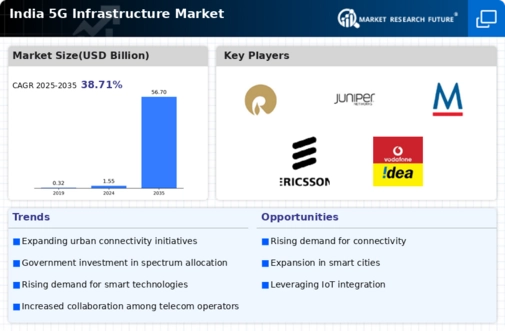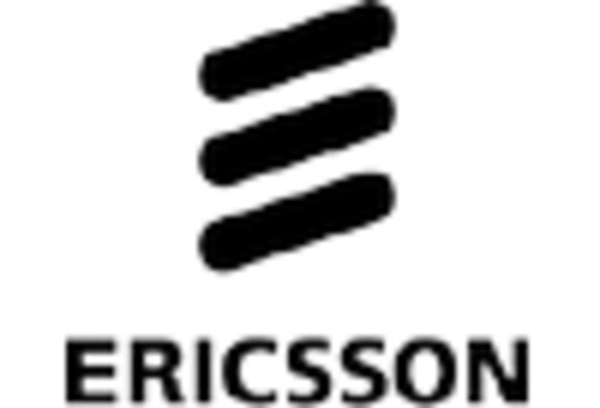Growth of IoT and Smart Devices
The proliferation of Internet of Things (IoT) devices and smart technologies is significantly influencing the 5g infrastructure market in India. With an estimated 1.5 billion connected devices expected by 2025, the demand for high-speed, low-latency networks is becoming increasingly critical. 5G technology is uniquely positioned. to support the vast number of devices that require constant connectivity, enabling applications such as smart homes, industrial automation, and smart agriculture. This growth in IoT adoption is likely to drive investments in 5g infrastructure, as telecom operators seek to enhance their network capabilities to accommodate the increasing data traffic generated by these devices. Consequently, the expansion of the IoT ecosystem is anticipated to be a key driver for the 5g infrastructure market.
Government Initiatives and Policy Support
Government initiatives play a crucial role in shaping the 5g infrastructure market in India. The Indian government has launched several policies aimed at promoting the deployment of 5g technology, including the National Digital Communications Policy, which envisions a comprehensive framework for digital infrastructure. Additionally, the allocation of spectrum for 5g services is expected to be expedited, allowing telecom operators to roll out services more efficiently. The government's commitment to enhancing digital infrastructure is reflected in its target to achieve 1 billion broadband connections by 2025. Such supportive policies are likely to create a conducive environment for investments in the 5g infrastructure market, fostering competition and innovation among service providers.
Increased Focus on Digital Transformation
The ongoing digital transformation across various sectors in India is a significant driver for the 5g infrastructure market. Businesses are increasingly adopting digital technologies to enhance operational efficiency, improve customer experiences, and drive innovation. The shift towards cloud computing, big data analytics, and AI applications necessitates a robust and high-speed network, which 5G technology can provide.. As organizations invest in digital solutions, the demand for 5g infrastructure is expected to rise, with projections indicating that the market could reach a valuation of $10 billion by 2025. This transformation is likely to create new opportunities for telecom operators and technology providers, further stimulating growth in the 5g infrastructure market.
Rising Demand for High-Speed Connectivity
The increasing demand for high-speed connectivity in India is a primary driver for the 5g infrastructure market. As digital transformation accelerates across various sectors, including education, healthcare, and entertainment, the need for faster and more reliable internet services becomes paramount. According to recent estimates, the number of internet users in India is projected to reach over 900 million by 2025, further intensifying the demand for robust 5g infrastructure. This surge in connectivity requirements is likely to compel telecom operators to invest heavily in 5g networks, thereby propelling the growth of the 5g infrastructure market. Enhanced connectivity is expected to facilitate innovations in smart cities, IoT applications, and remote work solutions, making it a critical factor in the market's expansion.
Competitive Landscape Among Telecom Operators
The competitive landscape among telecom operators in India is a vital driver for the 5g infrastructure market. Major players are actively investing in the development and deployment of 5g networks to gain a competitive edge. With the entry of new players and the expansion of existing ones, the market is witnessing intensified competition, which is likely to lead to innovative service offerings and pricing strategies. As operators strive to capture market share, they are expected to allocate substantial resources towards enhancing their 5g infrastructure. This competitive dynamic is anticipated to accelerate the rollout of 5g services, thereby contributing to the overall growth of the 5g infrastructure market in India.
















